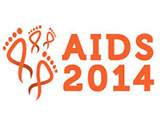 Lesions that can be a precursor to anal cancer are highly common in gay HIV-positive men, but they may clear without the need for treatment, aidsmap reports. Researchers are in the process of enrolling 600 gay men of both HIV statuses by July 2015 in the prospective Study of the Prevention of Anal Cancer (SPANC). They conducted an interim analysis focused on the first 450 men to be recruited through June 2014 and presented their findings at the 20th International AIDS Conference (AIDS 2014) in Melbourne.
Lesions that can be a precursor to anal cancer are highly common in gay HIV-positive men, but they may clear without the need for treatment, aidsmap reports. Researchers are in the process of enrolling 600 gay men of both HIV statuses by July 2015 in the prospective Study of the Prevention of Anal Cancer (SPANC). They conducted an interim analysis focused on the first 450 men to be recruited through June 2014 and presented their findings at the 20th International AIDS Conference (AIDS 2014) in Melbourne.
The study is unfolding as follows: The participants make five study visits over three years at which they receive anal swabs, HPV tests, cytology (an examination of cell changes) and high-resolution anoscopy to look for abnormalities in the rectal tissue. If there are abnormalities, a biopsy is conducted in order to assess histology (an examination of tissue changes). The men are diagnosed with high-grade squamous intraepithelial lesions (HSIL) if they have either cytological or histological evidence.
At the outset, 46 percent of the HIV-positive men had HSIL, compared with 34 percent of the HIV-negative men. The two groups had similar cytological abnormalities, but the men with HIV had a higher rate of histological abnormalities.
Out of the 197 participants who did not have HSIL at the beginning of the study, 45 developed new cases during the study, for an incidence rate of 16 cases per 100 person-years. The incidence rate was 23 per 100 person-years among men with HIV, compared with a rate of 13 per 100 person-years among those without the virus. The HIV-positive men’s relatively higher rate was not statistically significant, however, meaning it could have occurred by chance.
The participants who, at the study’s outset, had HPV-16, HPV-18 or other high-risk strains of human papillomavirus had a significantly higher risk of developing HSIL. Men with HPV-16 that was persistently positive throughout the study developed HSIL at a rate of 56 per 100 person-years. Those who contracted HPV-16 during the study had an HSIL incidence rate of 116 per 100 person-years.
There were 112 men with HSIL at the beginning of the study, 61 of whom spontaneously cleared the condition, for a rate of 42 per 100 person-years. The clearance rates were similar for men of either HIV status.
To read the aidsmap story, click here.
To read the conference abstract, click here.
Advertisement
Advertisement
Advertisement






2 Comments
2 Comments